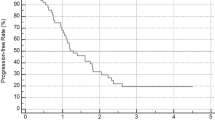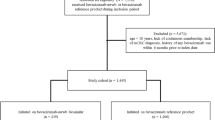Abstract
Purpose
We used real-world claims data to assess the utility of the relatively novel therapeutic bevacizumab in patients with newly diagnosed ovarian cancer in the United States after release of clinical data but prior to FDA approval.
Methods
We used the IQVIA Pharmetrics Plus commercial claims database to identify women with a new diagnosis of ovarian cancer who underwent primary surgery or neoadjuvant chemotherapy followed by interval surgery from 2006 to 2018. We calculated the rate of use of bevacizumab, and the relative frequency of hospital and emergency department (ED) admissions. Treatment-related toxicities, and time to second line chemotherapy were calculated.
Results
Among 8923 women who met study parameters, 533 (6.0%) received bevacizumab. The rate of use increased over time from 1.5% in 2006 to 7.0% in 2017 (P < 0.001), with a peak of 8.6% in 2011. The use was lowest in those ≥ 70 years old (2.8%), and in the West (4.5%), and was unaffected by number of comorbidities. Over one third (35.1%) received bevacizumab for less than 3 months, and 15.9% remained on it for greater than 13 months. Bevacizumab use was not associated with hospitalization or ED admission. Toxicities included hypertension (15.0%), kidney damage (6.8%), bleeding (3.8%), venous thrombo-embolism (2.3%) and fistula (1.1%). Time from initiation of first line chemotherapy to initiation of second line therapy was 19.9 months without bevacizumab and 22.6 months with bevacizumab use.
Conclusions
Real-world patterns of upfront bevacizumab use prior to FDA approval in 2018 differed significantly from trial data.


Similar content being viewed by others
Data availability
The study utilized commercially available data.
References
Siegel RL, Miller KD, Jemal A (2020) Cancer statistics, 2020. CA Cancer J Clin 70(1):7–30. https://doi.org/10.3322/caac.21590[publishedOnlineFirst:2020/01/09]
Burger RA, Sill MW, Monk BJ et al (2007) Phase II trial of bevacizumab in persistent or recurrent epithelial ovarian cancer or primary peritoneal cancer: a gynecologic oncology group study. J Clin Oncol 25(33):5165–5171. https://doi.org/10.1200/JCO.2007.11.5345 ([publishedOnlineFirst:2007/11/21])
Pujade-Lauraine E, Hilpert F, Weber B et al (2014) Bevacizumab combined with chemotherapy for platinum-resistant recurrent ovarian cancer: the AURELIA open-label randomized phase III trial. J Clin Oncol 32(13):1302–1308. https://doi.org/10.1200/JCO.2013.51.4489 ([publishedOnlineFirst:2014/03/19])
Coleman RL, Brady MF, Herzog TJ et al (2017) Bevacizumab and paclitaxel-carboplatin chemotherapy and secondary cytoreduction in recurrent, platinum-sensitive ovarian cancer (NRG oncology/gynecologic oncology group study GOG-0213): a multicentre, open-label, randomised, phase 3 trial. Lancet Oncol 18(6):779–791. https://doi.org/10.1016/S1470-2045(17)30279-6 ([publishedOnlineFirst:2017/04/26])
Aghajanian C, Blank SV, Goff BA et al (2012) OCEANS: a randomized, double-blind, placebo-controlled phase III trial of chemotherapy with or without bevacizumab in patients with platinum-sensitive recurrent epithelial ovarian, primary peritoneal, or fallopian tube cancer. J Clin Oncol 30(17):2039–2045. https://doi.org/10.1200/JCO.2012.42.0505 ([publishedOnlineFirst:2012/04/25])
Burger RA, Brady MF, Bookman MA et al (2011) Incorporation of bevacizumab in the primary treatment of ovarian cancer. N Engl J Med 365(26):2473–2483. https://doi.org/10.1056/NEJMoa1104390 ([publishedOnlineFirst:2011/12/30])
Burger RA, Brady MF, Rhee J et al (2013) Independent radiologic review of the gynecologic oncology group study 0218, a phase III trial of bevacizumab in the primary treatment of advanced epithelial ovarian, primary peritoneal, or fallopian tube cancer. Gynecol Oncol 131(1):21–26. https://doi.org/10.1016/j.ygyno.2013.07.100 ([publishedOnlineFirst:2013/08/03])
Oza AM, Cook AD, Pfisterer J et al (2015) Standard chemotherapy with or without bevacizumab for women with newly diagnosed ovarian cancer (ICON7): overall survival results of a phase 3 randomised trial. Lancet Oncol 16(8):928–936. https://doi.org/10.1016/S1470-2045(15)00086-8 ([publishedOnlineFirst:2015/06/28])
Cohn DE, Kim KH, Resnick KE et al (2011) At what cost does a potential survival advantage of bevacizumab make sense for the primary treatment of ovarian cancer? A cost-effectiveness analysis. J Clin Oncol 29(10):1247–1251. https://doi.org/10.1200/JCO.2010.32.1075 ([publishedOnlineFirst:2011/03/09])
Randall LM, Monk BJ (2010) Bevacizumab toxicities and their management in ovarian cancer. Gynecol Oncol 117(3):497–504. https://doi.org/10.1016/j.ygyno.2010.02.021 ([publishedOnlineFirst:2010/04/07])
FDA approves bevacizumab in combination with chemotherapy for ovarian cancer 2018 Available from: https://www.fda.gov/drugs/resources-information-approved-drugs/fda-approves-bevacizumab-combination-chemotherapy-ovarian-cancer accessed January 4 2020.
Eisenhauer EA. Real-world evidence in the treatment of ovarian cancer. Ann Oncol 2017;28(suppl_8):viii61-viii65. https://doi.org/10.1093/annonc/mdx443 [published Online First: 2017/12/13]
Yu N, Xiao Y, Yi J et al (2017) Real world treatment patterns of patients with ovarian cancer receiving first line chemotherapy in the United States. Value in Health 20(9):A473
Beachler DC, Lamy FX, Russo L et al (2020) A real-world study on characteristics, treatments and outcomes in US patients with advanced stage ovarian cancer. J Ovarian Res 13(1):101. https://doi.org/10.1186/s13048-020-00691-y ([publishedOnlineFirst:2020/09/02])
Bertelli G, Drews F, Lutchman-Singh K (2016) Bevacizumab for ovarian cancer at high risk of progression: reproducibility of trial results in “real-world” patients. Anticancer Res 36(9):4947–4950. https://doi.org/10.21873/anticanres.11061 ([publishedOnlineFirst:2016/09/16])
Perren TJ, Swart AM, Pfisterer J et al (2011) A phase 3 trial of bevacizumab in ovarian cancer. N Engl J Med 365(26):2484–2496. https://doi.org/10.1056/NEJMoa1103799 ([publishedOnlineFirst:2011/12/30])
Hall M, Bertelli G, Li L et al (2020) Role of front-line bevacizumab in advanced ovarian cancer: the OSCAR study. Int J Gynecol Cancer 30(2):213–220. https://doi.org/10.1136/ijgc-2019-000512 ([publishedOnlineFirst:2019/11/30])
Marlow NM, Pavluck AL, Bian J, et al. The relationship between insurance coverage and cancer care: a literature synthesis. Research Triangle Park (NC)2009.
Buckanovich RJ, Rustin G, Uppal S et al (2019) No role for maintenance bevacizumab for up-front stage IIIc (R0) ovarian cancer. J Clin Oncol 37(29):2707–2708. https://doi.org/10.1200/JCO.19.01650 ([publishedOnlineFirst:2019/08/27])
Stark D, Nankivell M, Pujade-Lauraine E et al (2013) Standard chemotherapy with or without bevacizumab in advanced ovarian cancer: quality-of-life outcomes from the international collaboration on ovarian neoplasms (ICON7) phase 3 randomised trial. Lancet Oncol 14(3):236–243. https://doi.org/10.1016/S1470-2045(12)70567-3 ([publishedOnlineFirst:2013/01/22])
Hinde S, Epstein D, Cook A et al (2016) The cost-effectiveness of bevacizumab in advanced ovarian cancer using evidence from the ICON7 Trial. Value Health 19(4):431–439. https://doi.org/10.1016/j.jval.2016.01.013 ([publishedOnlineFirst:2016/06/22])
Barnett JC, Alvarez Secord A, Cohn DE et al (2013) Cost effectiveness of alternative strategies for incorporating bevacizumab into the primary treatment of ovarian cancer. Cancer 119(20):3653–3661. https://doi.org/10.1002/cncr.28283 ([publishedOnlineFirst:2013/08/08])
Lee JY, Kim K, Lee YS et al (2016) Treatment preferences of advanced ovarian cancer patients for adding bevacizumab to first-line therapy. Gynecol Oncol 143(3):622–627. https://doi.org/10.1016/j.ygyno.2016.10.021 ([publishedOnlineFirst:2016/10/25])
Audibert C, Perlaky A, Stuntz M et al (2017) Variability in the therapeutic management of advanced ovarian cancer patients: a five-country survey of oncologists. Drug Des Devel Ther 11:3471–3479. https://doi.org/10.2147/DDDT.S151420 ([publishedOnlineFirst:2017/12/20])
Monk BJ, Lammers PE, Cartwright T, et al. Barriers to the Access of Bevacizumab in Patients with Solid Tumors and the Potential Impact of Biosimilars: A Physician Survey. Pharmaceuticals (Basel) 2017;10(1) https://doi.org/10.3390/ph10010019 [published Online First: 2017/01/31]
Funding
Funding was provided by Merck.
Author information
Authors and Affiliations
Contributions
CG: project development, data analysis, manuscript writing/editing. LC: data management, data analysis, manuscript writing/editing. ES: data management, data analysis, manuscript writing/editing. MM: project development, data analysis, manuscript writing/editing. DH Project development, data analysis, manuscript writing/editing. JW: project development, data analysis, manuscript writing/editing.
Corresponding author
Ethics declarations
Conflicts of interest
Dr. Wright received honorary from Clovis Oncology and royalties from UpToDate.
Ethics approval
This study was approved by the Columbia University Institutional Review Board.
Additional information
Publisher's Note
Springer Nature remains neutral with regard to jurisdictional claims in published maps and institutional affiliations.
Supplementary Information
Below is the link to the electronic supplementary material.
Rights and permissions
About this article
Cite this article
Gamble, C.R., Chen, L., Szamreta, E. et al. Patterns of use and outcomes of adjuvant bevacizumab therapy prior to regulatory approval in women with newly diagnosed ovarian cancer. Arch Gynecol Obstet 305, 1647–1654 (2022). https://doi.org/10.1007/s00404-021-06282-6
Received:
Accepted:
Published:
Issue Date:
DOI: https://doi.org/10.1007/s00404-021-06282-6




